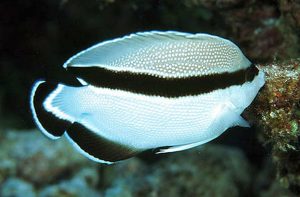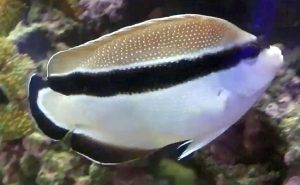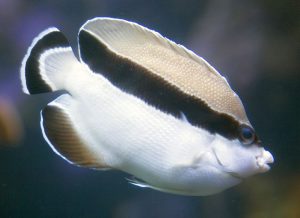The Black & White Bandit Angelfish (Holacanthus arcuatus) known to tropical fish keeping enthusiasts as the Black Banded Angelfish, Bandit Angelfish, Black Banded Angelfish and Black and White Banded Angelfish is a rare species found along the outer deep water ledges outside of the reefs in the Hawaiian and Johnston Islands in the Pacific Ocean.
Black & White Bandit Angelfish are a shy, reclusive, deep water species that inhabit the caves, overhangs, crevices’, and rocky ledges found in faster moving waters at depths up to 500 feet. Although they are occasionally seen as shallow as 50 feet; they are considered a deep water species.
The Black & White Bandit Angelfish has a distinctive, almost pearlescent white body color with a broad black band accented by a narrow white band above that runs from the nose of the fish to the top of the caudal fin.
The lower part of the anal and rear of the caudal fins have a broad black band edged with white. The body color above the band is a slightly darker, almost light gray color. Below the band the body is a shimmering, pearlescent white color. The result is a spectacular, eye catching “masked bandit” like appearance.
Holacanthus arcuatus are virtually impossible to sex but like many angelfish, they are Hermaphroditic and can change gender from female to male when necessary.
Because the Black & White Bandit Angelfish is collected from depths often well below 50 feet, they are subject to decompression sickness when brought to the surface too quickly. Depending on the depth, decompression can take up to several hours to accomplish, which is why some divers use needles to puncture the air bladder of the fish to allow a faster surface when specimens are collected deep. When not done properly, this can cause infections in the fish.
Black & White Bandit Angelfish are best housed as a single specimen in a well established deep water reef aquarium of at least 150 gallon capacity with plenty of live rock arranged into caves, crevices, and overhangs for them to graze and hide among when they feel threatened. The larger the tank, the easier they will be to care for. Their deep water habitat requires cooler water temperatures, pristine water quality, and a fast flowing current; which means that an aquarium chiller, several powerheads
, and regular water changes are mandatory. Because they come from a low light environment, dim lighting is also recommended until the fish can be acclimated to normal lighting levels.
Black & White Bandit Angelfish are shy and generally easy going with other species, however, they can be quite aggressive with other angelfish and other species of about their same size. Good tankmates include smaller, peaceful species like Anthias, chromis, blennies, etc. They do well in reef tanks but will naturally nip on live coral and sponges.
Professional breeders have found this species extraordinarily difficult to breed, but to date, there have been no reports of tropical fish keeping enthusiasts breeding Black and White Bandit Angelfish in an aquarium environment.
In their natural deep water habitat, Black & White Bandit Angelfish hide in caves and overhangs where stony and soft corals grow. They are omnivores that feed on filamentous sponges, tunicates, benthic algae, weeds, invertebrates, and fish eggs which is why they can easily starve in captivity.
Most specimens will eventually adapt to tank food in an aquarium that contains substantial amounts of live rock with marine algae for grazing. They should also be provided supplemental feedings of live or frozen meaty angelfish preparations that include sponge as the main ingredient. San Francisco Bay and Ocean Nutrition brands both have frozen formulas that contain these ingredients. Live foods such as freshly chopped seafoods and vitamin fortified shrimp will usually spike their appetites and get them to start eating.
Because of the difficulty in collecting from their deep water environment, the difficulty in acclimating, and extreme difficulty in breeding captured Black & White Bandit Angelfish in captivity; the vast majority of Holacanthus arcuatus are captured in the wild and can cost tropical fish keeping enthusiasts anywhere from $800-$1000 or more. Although they are occasionally available from importers, wholesalers, and retailers online by special order; make sure that you can inspect this fish carefully before purchasing and can be guaranteed that it is eating in captivity.
Minimum Tank Size: 150 gallons
Aquarium Type: Deepwater Reef
Care Level: Extremely Difficult
Temperament: Peaceful
Aquarium Hardiness: Hardy when acclimated
Water Conditions: 72-78°F, dKH 8 to 12 , pH 8.1 – 8.4, sg 1.020-1.025
Max. Size: 7″
Color Form: Black, White
Diet: Omnivore
Compatibility: Reef w/Caution
Origin: Hawaiian and Johnston Islands
Family: Pomacanthidae
Lifespan: 2 to 5 years
Aquarist Experience Level: Expert





One Response to “Black & White Bandit Angelfish (Holacanthus arcuatus)”
Trackbacks/Pingbacks
[…] only other marine angelfish that has similar bold black and white patterning is the Bandit angelfish (Apolemichthys arcuatus) from […]